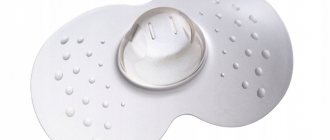Anastasia Safina (author of the publication)
Hello, Anastasia Safina here! The lack or absence of milk causes concern in a woman and forces her to abandon natural feeding in favor of formula. This solution is not always justified - in most cases, lactation can be improved. I tell you what to do to ensure that your mother has enough breast milk.
Sometimes a mother judges a decrease in lactation only by external signs - the breasts have become smaller, she does not feel hot flashes. These symptoms do not indicate a lack of milk. Let's figure out what signs of insufficient lactation can be considered reliable and how to make a woman produce more breast milk.
Why doesn't my milk come in immediately after giving birth?
Mothers often ask me what to do if there is no milk after childbirth. First of all, I advise you to find out whether this is really so!
Even during pregnancy, the mother’s body gradually increases the production of prolactin, a hormone that plays a big role in lactation. Immediately after birth, the newborn is fed colostrum, which is produced during pregnancy. It is more concentrated than milk, and even a small amount of colostrum is enough to satiate the baby. Therefore, in the first days, the breasts may not look full.
Usually milk arrives 3-4 days after natural birth and 5-7 after cesarean section. So if you don’t feel hot flashes or fullness in your chest immediately after giving birth, this is absolutely normal. Early latching of the baby is important in stimulating lactation. The sooner the newborn begins to breastfeed, the more favorable this will affect lactation. To properly organize the feeding process from the first days, sign up for our online course on breastfeeding (BF) https://legkie-rody.ru/grudnoe.
In general, mother’s worries about the lack of food for the baby are often unfounded. True lack of milk is very rare and occurs only in a small percentage of women. I'll tell you how to find out if your baby has enough food.
How do you know if you really don't have enough milk?
Hypogalactia is a true lack of milk, which is detected only in 3-8% of women. Agalactia - its complete absence, is even less common. A decrease in the function of the mammary glands does not occur out of the blue in an absolutely healthy woman; this phenomenon has serious prerequisites. The cause of hypogalactia can be:
- thyroid dysfunction;
- remains of the placenta in the uterus;
- breast hypoplasia;
- major breast surgery;
- Sheehan's syndrome;
- congenital prolactin deficiency;
- severe malnutrition or prolonged fasting.
How to breathe properly and relax during childbirth
to give birth easily without complications?
Register for our free master class
and immediately after registration you will receive a free video lesson “How to relieve pain in childbirth?” Get it for free
If none of the above reasons apply to you, but you still suspect you have hypogalactia, there are accurate ways to determine whether your baby is getting enough food. I'll tell you how to do it:
- Number of urinations. If the baby (after the 10th day of life) pees more than 10-12 times a day (or even better, 14 times a day), and the urine is clear and odorless, he has enough nutrition. To count your urinary frequency, temporarily ditch diapers in favor of swaddling clothes.
- Number of bowel movements. A child who has enough food has bowel movements at least 2-3 times a day for the first 1-2 months. Then stool occurs less frequently - once a day or even once every few days.
- Weight gain. This is the main indicator of whether the baby is getting enough food. If a child over 7 days old gains from 125 to 500 grams per week, then he does not need additional feeding. Although normally, in the first months, weight gain is faster, and then decreases (an increase of 125 grams per week in the first month of a child’s life is still a reason to sort out the organization of breastfeeding and latching).
Only these three criteria are decisive in identifying a lack of milk. The conclusion that you have hypogalactia cannot be made based on the following facts:
- the milk stopped leaking;
- mammary glands do not fill;
- it seems to you that the baby sucks too often and for a long time;
- baby cries after feeding;
- you are unable to express enough milk.
In fact, leakage, like the feeling of fullness in the mammary glands, is not related to the amount of milk. When lactation is established, the breasts become smaller and milk is released only during sucking. Frequent and prolonged sucking is the absolute norm for a baby. If a baby cries after feeding, there may be other reasons for this, for example, colic, wet diapers, or physical discomfort. Pumping is also not an indicator - only the child can stimulate the breast so that the nutrient fluid is produced in the right quantity.
Often mothers are concerned about the following points:
- Approximately closer to a month, the breasts sag, become soft, and you might think that they are empty, but this is not so. Lactation has improved, and milk is now produced in response to the baby's sucking, there is no reason to worry.
- Closer to 10 months, the rate of weight gain in children decreases - this is due to an increase in physical activity. During this period, a woman may decide that the baby is not eating enough.
Sometimes milk becomes less due to external reasons. Next I’ll tell you what usually contributes to the extinction of lactation in women.
Causes of lack of breast milk
If the mother has established for sure that the baby is not eating enough, you need to find out the reason for the lack of milk. If the problem is not related to pathology or disease, then we are talking about a lactation crisis. A lactation crisis is a temporary lack of milk. It usually lasts from 3 days to 2 weeks.
Causes:
- improper organization of breastfeeding - the mother feeds the baby incorrectly: for example, she transfers it to another breast without first emptying the first one, takes long breaks in feeding, uses a pacifier, and often feeds from a bottle with a nipple. If you properly establish breastfeeding, then, most likely, milk will begin to arrive in the required quantity;
- improper organization of nutrition for a nursing mother - perhaps she does not have enough fluid in her diet, you should carefully choose dishes and products. Increasing the proportion of soups and drinks will help improve lactation;
- Stress, exercise, fatigue and nervous tension can also negatively affect milk production;
- using formula - the child eats up the formula and does not suck the breast completely, which entails a decrease in milk production;
- features of child development.
At 3 months
There is no milk shortage as such. The body adapts to lactation, external signs of milk supply disappear - tingling and fullness of the breast.
6-7 months
- introduction of complementary foods. Gradually, one feeding is replaced by complementary foods, and accordingly, the amount of milk decreases.
9-10 months
– the child moves more, growth rates decrease, and less milk is required.
Why does breast milk disappear?
The principle of lactation is that demand creates consumption. This means that the more the baby eats, the more milk the mother produces. More often, the cause of the deficiency is an incorrect approach to organizing feeding. Let's figure out why milk disappears:
- Unreasonable supplementary feeding and supplementation. This leads to the fact that the baby's stomach is full, and he feels full faster, which means he sucks less.
- Using pacifiers. If the baby is breastfeeding, pacifiers can harm lactation. This can lead to an incorrect breast latch. In addition, the sucking reflex is satisfied and breast stimulation is reduced.
- Limiting feeding time, increasing the intervals between feedings. Feeding on a schedule will only lead to the baby eating less than he needs. This means that his mother will have less food for him.
- Frequent separations from mother. If a woman is often separated from her baby and does not pump, lactation may decrease. When using a breast pump, it is important to remember that it cannot always express as well as the baby does.
Stress can be called an indirect cause of decreased milk supply. In fact, under severe stress, the volume of fluid released does not decrease, but the process of its separation itself worsens. In a stressful situation, try to apply the baby more often and quickly find a way for yourself to return to normal.
The main reasons for insufficient milk production are associated with improper behavior of the mother. To avoid common mistakes, read my article on the main rules of breastfeeding.
So, you have reliably established that you have a lack of milk. Don’t despair, nature is stubborn, most often lactation can be improved. Let's find out how to do it!
Milk has disappeared - what to do?
The most important thing is not to panic! If desired, almost any problems with heated water can be solved. First you should try the simplest and most obvious methods.
Natural ways
Avoid stress, smoking, taking oral contraceptives, overwork - any of these factors can negatively affect lactation. I'll tell you what else can help:
- Correct chest grip. Often a child cannot fully empty the breast due to improper attachment. The baby should grasp the nipple along with the areola, with more of the areola being grasped from below, from the side of the baby's chin. If you cannot correct the seizure yourself, contact a breastfeeding consultant.
- Increasing the number of applications. Do not limit the number and duration of feedings; try to feed your baby as often as possible. If your baby sleeps for more than 3 hours, you should wake him up and put him to the breast. In response to frequent suckling, the body will begin to produce more milk.
- Chest compression method (author: Canadian pediatrician Jack Newman). Place your palm at the base of your breast and squeeze it slightly when feeding - this will help your baby get milk more easily.
- Stimulation. If your baby sucks rarely or weakly, additionally use a breast pump or hand expression. This will give the body a signal that not enough milk is being produced and the baby needs more food.
- Breastfeeding system (for example, SNS). The method can help even if the mother has no milk at all. You need to purchase a special device - a bottle with a long tube. The essence of the method is that the baby grasps the mother's breast along with one end of the tube and, in the process of sucking out the mixture, at the same time stimulates the breast.
The recommendations can be used alternately or in combination with each other. The main thing is persistence and regularity.
We have found that lack of milk is rare and usually correctable. The main way to increase lactation is to follow all feeding rules and feed your baby as often as possible. Show patience and perseverance, then the process will definitely improve, and you will be able to enjoy feeding your baby.
Did you like the post? Share it on social networks!
Telegram
Tweet
We recommend that you read similar articles:
- Basic rules for breastfeeding
- What are the benefits of breastfeeding?
- What is lactostasis and what mistakes happen when treating it?
How to increase lactation
To increase lactation, it is necessary to identify and eliminate the causes of lack of milk:
- increase the number of breastfeeding;
- apply on demand, not by the clock;
- apply to the breast at night, every 2.5-3 hours;
- introduce co-sleeping with the child (it also has a positive effect on increasing lactation);
- Make sure that when feeding, the baby grasps the entire nipple, the baby’s lips are turned out, and the nose and cheeks are adjacent to the breast;
- make sure that the baby is applied to each breast in turn: if there is less milk in one breast, then you need to offer it first, and then give a full breast and finish again first;
- express milk after feeding (expressing will increase the amount of milk);
- exclude nipples and pacifiers; if additional feeding is necessary, it is better to do this from a spoon or from a syringe without a needle;
- use comfortable feeding positions;
- review the menu of a nursing mother, introduce more liquid dishes and products that stimulate lactation; hot meals should be served 3 times a day, the total amount of liquid should be 2-3 liters per day;
- use lactation teas and products;
- massage your chest to increase lymphatic drainage;
- establish your own daily routine;
- introduce mandatory walks in the fresh air;
- get more rest;
- avoid stressful situations;
- 30 minutes before feeding, drink tea with milk;
- apply warm compresses before feeding and cool compresses after;
- Before feeding and before pumping, massage your breasts under a warm shower.
Photo source: shutterstock.com











